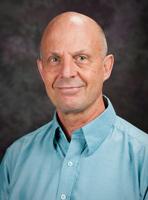NSF REU at K-State: Laser-matter Interactions at the Atomic and Nanoscales
The K-State REU program offers summer fellowships to do world-class research in our friendly physics department in the scenic Flinthills. We are funded by the National Science Foundation.
Atomic, Molecular & Optical Physics (AMO)
 Dr. Itzik Ben-Itzhak: Fast beams of neutral molecules – the next generation of laser induced molecular dissociation imaging
Dr. Itzik Ben-Itzhak: Fast beams of neutral molecules – the next generation of laser induced molecular dissociation imaging
Email: ibi@phys.ksu.edu
During the 2013 REU program our research group will be involved in projects where undergraduate students can do interesting work and contribute to our research progress. Below I have briefly outlined a project which would best fit an REU student. This project involves significant technical development leading to advanced imaging of laser induced fragmentation of fast beams of neutral molecules. In addition, undergraduate students can get involved in other summer projects within our group [1]. Our research group includes my graduate students Nora Johnson, Mohammad Zohrabi, Utuq Ablikim, Ben Berry, Bethany Jochim [2], and Travis Severt [2], and my postdoc Kelsie Betsch. The REU student is expected to work closely with them and under the guidance of Dr. Kevin Carnes and myself.
For about a decade, we have been studying the interaction of intense ultrafast laser pulses with fast molecular ions through the application of a coincidence three-dimensional momentum imaging technique[3]. One promising extension of these studies involves probing the naturally abundant neutral molecules. By using a fast beam of such neutral molecules instead of the commonly used stationary target, one can detect all neutral fragments, thus enabling the study of the neutral fragmentation channels which are hard to explore by other means. To that end we plan to neutralize a fast moving beam of molecular ions and then deflect away the remaining ions, thus producing the desired neutral beam. As simple as it may sound, the technical challenges are numerous, starting from increasing the neutralization efficiency while maintaining the ultra-high vacuum needed for the laser interaction experiments, to separating the neutral beam from the beam of the parent ions and measuring its "particle current". These are examples of expected experimental challenges, but other difficulties might be discovered along the way. The REU project will involve designing, constructing, and testing the beam neutralization setup as well as the devices used to monitor the beam "current". During idle times while waiting for the machining of parts, the student will participate in some experiments using ion beams in order to learn the relevant experimental techniques and also the physics describing the laser-ion interactions. For example, one such measurement involves the dissociation of a molecular ion into three fragments. This exposure to several different experiments will ensure that the student leaves at the end of the summer with a solid foundation in experimental technique, no matter how far her or his own experiment progresses.
[1] It is important to note that the specific involvement of the REU student in any of the projects will depend on the qualifications and interests of the student as well as our needs at the time.
[2] Former participants in the REU program of 2010 and 2011, respectively.
[3] See, for example, J. McKenna et al. New J. Phys. 14, 103029 (2012); Phys. Rev. A 81, 061401(R) (2010); Phys. Rev. Lett. 103, 103004 (2009); and Phys. Rev. Lett. 103, 103006 (2009).
 Dr. Vinod Kumarappan: High Harmonic Generation from Aligned Molecules
Dr. Vinod Kumarappan: High Harmonic Generation from Aligned Molecules
Email: vinod@phys.ksu.edu
A very interesting and useful aspect of the interaction of high intensity laser pulses with atoms and molecules is the generation of coherent light at large integer multiples of the laser frequency. This extremely non-linear phenomenon is called high harmonic generation and provides us with the means to produce very short pulses of XUV light. Harmonic photons are produced when the laser field removes an electron from an atom or molecule, accelerates it to high energies and then – as the oscillating laser electric filed reverse direction – sends it back to the parent ion. The electron can then recombine with the ion and release all its kinetic energy in the form of a high energy photon. The study of this XUV radiation gives us a path to investigating molecular physics with sub-femtosecond and picometer resolution.
In atoms, only the most weakly bound electron contributes to the harmonic signal because more tightly bound electrons are exponentially harder to ionize. One of the most interesting aspects of HHG from molecules to emerge in the past few years is the realization that, unlike in atoms, electrons that are more tightly bound than the highest occupied molecular orbital may contribute to HHG because the ionization rates depend not only on binding energy but also on the orientation of the molecules with respect to the laser polarization. These contributions are generally weaker than those from the most weakly bound electrons, but carry information about these lower lying orbitals that would otherwise be inaccessible. An important experimental challenge is to disentangle the contributions of these orbitals.
The goal of the summer research project is to design and build a new experiment to the measure the fluorescence spectrum from laser excited molecules. This spectrum carries information about the extent to which lower-lying orbitals have been ionized. The setup will include optics to efficiently collect light from inside a vacuum chamber, a home-built spectrometer and various physical and electronic means of stray light and noise reduction. A graduate student will also be involved in this project. Once functional, this setup will significantly enhance our ability to disentangle the contributions of various molecular orbitals in high harmonic generation from aligned molecules.
 Dr. Carlos Trallero: Strong Field Quantum Control and Spectroscopy
Dr. Carlos Trallero: Strong Field Quantum Control and Spectroscopy
Email: trallero@phys.ksu.edu
Prof. Carlos A Trallero works in the fields of Attosecond Science and Coherent Quantum Control. The main goal of this REU project is to achieve a better control of different molecular reactions. In order to achieve these goals, several developments need to take place. The REU student can discuss with Dr. Trallero the most suitable choice of one or two of these tasks:
- Design and build a new velocity map imaging (VMI) chamber to measure velocity and angular distribution of photo-fragments emerging from excited molecules
- Design, build and characterize a forth harmonic generation scheme to be used as a measure of molecular quantum excitations.
- Design and test a 10KHz pulsed valve to generate vibrationally cold molecules in the VMI apparatus.
- Join the undergoing research efforts in coherent quantum control. In particular, use of closed loop feedback algorithms to control photo-induced chemical reactions in molecules. Development of an XUV beam line. Using the same HHG process we can generate XUV radiation with energies up to 100eV. One possible project could be to design a chamber capable of producing intense XUV pulses and study how to optimize phase matching.
- Design and characterize a cold molecular beam to align and/or orient molecules respect to the laser pulse.
I believe that now is a very exciting time for a student to spend a summer with my group. The students can learn all the technical details by working in the developing face and they can also learn all the basic physics when working in the design of the experiment.